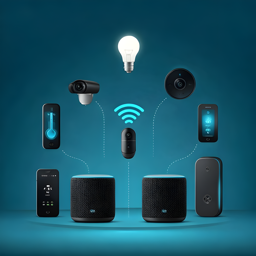Mastering ESP32: Rich Architecture & IoT Connectivity
ESP32 Architecture: Dual-core SoC, integrated RF subsystems
The ESP32 is a powerhouse in the world of IoT, offering a blend of processing power, integrated wireless capabilities, and energy efficiency. Its dual-core design and built-in RF subsystems make it a versatile choice for developers and engineers looking to build robust, scalable IoT solutions. In this article, we’ll dissect the ESP32’s architecture, focusing on its dual-core SoC, RF capabilities, and low-power design, and explore how these features enable seamless connectivity and efficient processing in real-world applications.
Table of Contents🔗
- Dual-Core SoC: Parallel Processing for IoT
- Integrated RF Subsystems: Wi-Fi, Bluetooth, and Beyond
- Memory Architecture: Balancing Speed and Efficiency
- Peripheral Interfaces: Bridging Sensors and Modules
- Power Management: Optimizing for Low Energy
- Practical Example: Configuring Dual-Core and RF Coexistence
- Real-World Applications of ESP32’s Architecture
- Best Practices for Maximizing ESP32’s Architecture
Dual-Core SoC: Parallel Processing for IoT
The ESP32 features two 32-bit Xtensa LX6 CPUs, clocked up to 240 MHz. This dual-core design allows for:
- Task Parallelism: Dedicate one core to wireless communication (e.g., Wi-Fi/BLE stack) and the other to application logic.
- Real-Time Responsiveness: Critical tasks like sensor sampling can run uninterrupted while background processes handle connectivity.
- Example Use Case: In a smart thermostat, Core 0 manages temperature sensing and HVAC control, while Core 1 handles MQTT communication with the cloud.
// Assign tasks to cores in FreeRTOS
xTaskCreatePinnedToCore(
TaskSensor, // Function for sensor handling
"SensorTask",
10000, // Stack size
NULL,
1, // Priority
NULL,
0 // Core 0
);
xTaskCreatePinnedToCore(
TaskWiFi, // Function for Wi-Fi communication
"WiFiTask",
10000,
NULL,
1,
NULL,
1 // Core 1
);
Integrated RF Subsystems: Wi-Fi, Bluetooth, and Beyond
The ESP32 integrates Wi-Fi 802.11b/g/n (2.4 GHz), Bluetooth Classic, and BLE 4.2+ radios. Key features include:
- Hardware-Based RF Control: Dedicated processors (e.g., WiFi MAC, BLE controller) reduce CPU overhead.
- Coexistence Mechanisms: Time-division multiplexing ensures Wi-Fi and BLE operate without interference.
| Component | Function |
|---|---|
| Baseband Processor | Encodes/decodes radio signals, handles modulation schemes. |
| RF Front-End | Manages antenna switching and signal amplification. |
- Practical Insight: Use
esp_wifi_set_ps(WIFI_PS_MIN_MODEM)to minimize Wi-Fi power consumption during BLE scans.
Memory Architecture: Balancing Speed and Efficiency
The ESP32 combines multiple memory types for flexibility:
- 448 KB ROM: Stores bootloader and core libraries.
- 520 KB SRAM: Split into fast (IRAM) and slow (DRAM) segments for code/data.
- 4 MB External Flash: Stores firmware and file systems.
- 8 KB RTC SRAM: Retains data during deep sleep.
- Tip: Use
RTOS_APP_CPUto allocate latency-sensitive tasks to Core 1’s tightly coupled memory (TCM).
Peripheral Interfaces: Bridging Sensors and Modules
The ESP32 supports 34+ GPIOs, 12-bit ADCs, SPI, I2C, UART, and CAN Bus, enabling seamless integration with external modules like LoRa or Zigbee.
- Example: Interfacing a LoRa module via SPI:
#include <SPI.h>
#define LORA_CS 5
void setup() {
SPI.begin(18, 19, 23); // SCK, MISO, MOSI
pinMode(LORA_CS, OUTPUT);
digitalWrite(LORA_CS, HIGH);
}
void sendLoRaPacket(byte* data, int len) {
digitalWrite(LORA_CS, LOW);
SPI.transfer(data, len);
digitalWrite(LORA_CS, HIGH);
}
Power Management: Optimizing for Low Energy
The ESP32 supports multiple power modes:
- Active Mode: Full operation (100–240 mA).
- Modem Sleep: Disables RF (3–20 mA).
- Deep Sleep: Shuts down CPUs, retains RTC memory (10 µA).
- Best Practice: Combine deep sleep with
esp_sleep_enable_timer_wakeup()for battery-powered sensors.
Practical Example: Configuring Dual-Core and RF Coexistence
Scenario: A weather station using Wi-Fi and BLE simultaneously.1. Core Allocation:
- Core 0: BLE advertising (low latency).
- Core 1: Wi-Fi HTTPS POST to cloud.
2. RF Coexistence Setup:
#include "esp_coexist.h"
void setup() {
esp_coex_preference_set(ESP_COEX_PREFER_BALANCED);
}
Real-World Applications of ESP32’s Architecture
The ESP32’s dual-core architecture and integrated RF subsystems make it suitable for a wide range of applications:
1. Smart Home Automation:
- Control lights, thermostats, and security systems using Wi-Fi or BLE.
- Example: A smart thermostat that uses Wi-Fi for cloud connectivity and BLE for local control via a smartphone app.
2. Industrial Monitoring:
- Collect and transmit sensor data over long distances using LoRa or NB-IoT modules.
- Example: A factory monitoring system that uses the ESP32 to collect data from sensors and send it to a central server via Wi-Fi or LoRa.
3. Wearable Devices:
- Use BLE for low-power communication with smartphones or other devices.
- Example: A fitness band that tracks activity and syncs data with a smartphone app using BLE.
4. Smart Agriculture:
- Monitor soil moisture, temperature, and other parameters using LoRa or Sigfox for long-range communication.
- Example: A soil monitoring system that uses the ESP32 to collect data and transmit it to a central hub using LoRa.
5. Mesh Networks:
- Create a mesh network using ESP-MESH for large-scale IoT deployments.
- Example: A smart lighting system in a large building where each light fixture communicates with its neighbors to form a mesh network.
Best Practices for Maximizing ESP32’s Architecture
1. Isolate RF Tasks: Assign Wi-Fi/BLE stacks to one core to avoid RTOS task starvation.
2. Leverage Hardware Acceleration: Use ESP32’s cryptographic engine for TLS/SSL.
3. Optimize Memory: Store large buffers in external SPI RAM (heap_caps_malloc(size, MALLOC_CAP_SPIRAM)).
4. Dynamic Frequency Scaling: Adjust CPU speed with setCpuFrequencyMhz() based on workload.
#include "esp_pm.h"
esp_pm_config_esp32_t pm_config = {
.max_freq_mhz = 240,
.min_freq_mhz = 80,
.light_sleep_enable = true
};
esp_pm_configure(&pm_config);
By leveraging the ESP32’s dual-core architecture, integrated RF subsystems, and low-power design, developers can create powerful, efficient, and scalable IoT solutions. Whether you’re building a smart home device, an industrial monitoring system, or a wearable, the ESP32 provides the tools you need to succeed.
Author: Marcelo V. Souza - Engenheiro de Sistemas e Entusiasta em IoT e Desenvolvimento de Software, com foco em inovação tecnológica.
References🔗
- Arduino Forum: forum.arduino.cc
- Arduino IDE Official Website: arduino.cc
- ESP-IDF Programming Guide: docs.espressif.com/projects/esp-idf
- ESP32 Arduino Core Documentation: docs.espressif.com/projects/arduino-esp32
- Espressif Documentation: docs.espressif.com
 3 months ago
3 months ago
 3 months ago
3 months ago
 3 months ago
3 months ago
 3 months ago
3 months ago
 3 months ago
3 months ago
 3 months ago
3 months ago
 3 months ago
3 months ago
 2 months ago
2 months ago
 2 months ago
2 months ago
 2 months ago
2 months ago
 3 months ago
3 months ago
 33 days ago
33 days ago
 3 months ago
3 months ago
 3 months ago
3 months ago
 3 months ago
3 months ago
 3 months ago
3 months ago
 3 months ago
3 months ago
 3 months ago
3 months ago
 3 months ago
3 months ago
 3 months ago
3 months ago
 2 months ago
2 months ago
 2 months ago
2 months ago
 2 months ago
2 months ago
 2 months ago
2 months ago
 2 months ago
2 months ago
 2 months ago
2 months ago
 2 months ago
2 months ago
 2 months ago
2 months ago
 2 months ago
2 months ago